My beautiful wife is about to leave the North American continent behind, visiting her Mom in Hungary.
The house feels a bit empty already. The cats are unusually quiet and subdued, too.
Looking at this image by Kyodo News showing the wreck of that Airbus 350 that burnt to a cinder at Haneda Airport the other day, I continue to feel astonished that not only did everyone survive, most of the almost 400 passengers were not even injured!
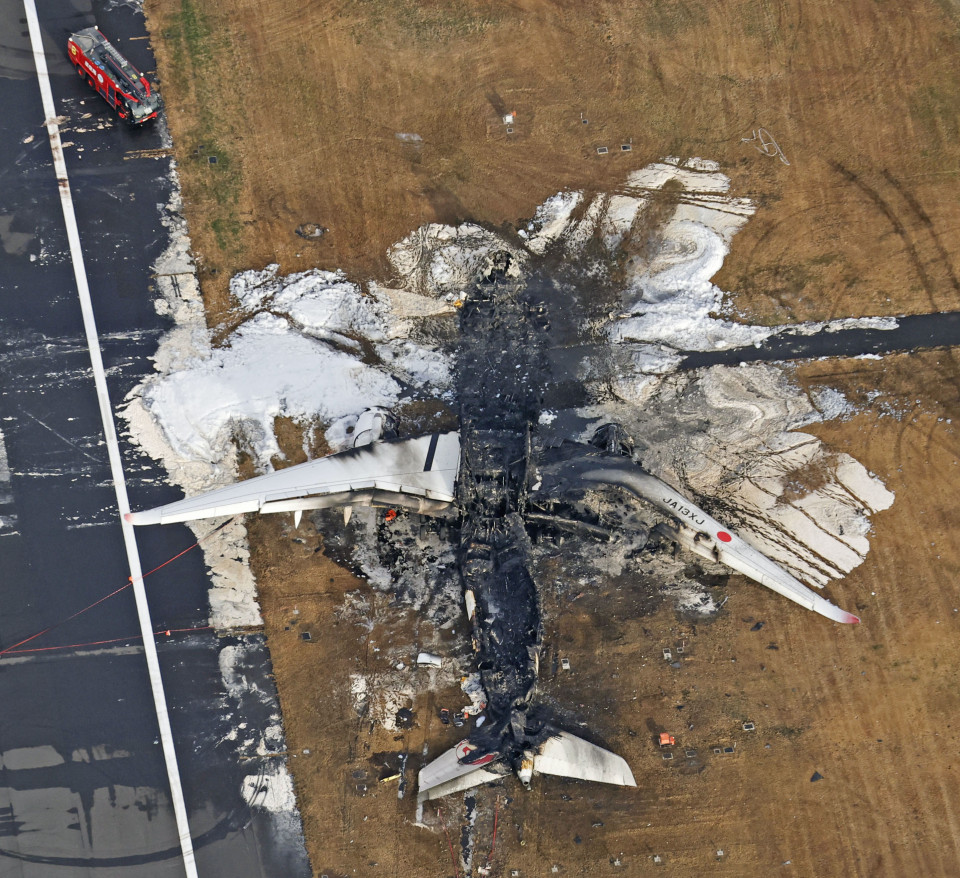
Photo taken from a Kyodo News helicopter on Jan. 3, 2024, shows a Japan Airlines plane a day after it caught fire on a runway at Haneda airport in Tokyo following a collision with a Japan Coast Guard aircraft while landing. (Kyodo)
It really boggles the mind. I hope that the JAL flight crew who facilitated what, for all intents and purposes, was a textbook successful evacuation from a severely damaged, burning aircraft, will get the recognition they deserve.
Although unwelcome, it was also a good test of the A350 airframe and its ability to protect passengers long enough for a successful evacuation.
This morning, a drone took flight. It successfully took off from the ground, hovered for a few seconds, and then landed safely.
What, you ask? How is this supposed to be a big deal? There are millions of drones out there, kids playing with them and whatnot.
Oh, but this drone is special, and not only because it carries a small piece of fabric from the Wright brothers’ very first airplane.
It is special because it flew on Mars.
Amidst all the tension that has been unleashed in the United States, there is this small ray of hope.
A black flight attendant on a Southwest flight initiated a conversation with a white passenger, who was reading the book White Fragility: Why It’s So Hard for White People to Talk About Racism, by Robin DiAngelo.
The white passenger’s remark, “It’s our fault. We have to start these conversations,” caught her by surprise. A short conversation followed. Then the big revelation: The unassuming gentleman happened to be Doug Parker, CEO of American Airlines.
I can already hear some of my friends objecting: “It’s not our fault!” Do not misconstrue Parker’s words (perhaps they weren’t even quoted verbatim.) He of course didn’t mean, I am sure, that every white person must bear personal responsibility for every vile act of racism that happens in America or elsewhere.
Rather, what I read into those words is an acknowledgement of a simple reality: In an unequal relationship, the dominant party has the power to make change for the better. In America, this means whites.
The fact that the CEO of a company as large as American Airlines recognizes this is, well, a ray of hope. As is the fact that he traveled, unassumingly, as an ordinary economy passenger on a competitor’s flight. As rising inequality between the super-wealthy and the stagnating middle class plagues Western societies, the US in particular, as disadvantaged minorities fall even further behind, it is nice to know that at least some folks in positions of power recognize that their wealth and status also come with a huge responsibility. Especially if the nice thoughts are also followed by deeds.
Two weeks, or to be precise, fifteen and a half days ago, I was walking the streets of downtown Vienna, enjoying a bright late winter day, eating a bit of authentic Viennese street food and a fabulous slice of cake in a Vienna coffee house. The next day, I boarded a flight at a busy Vienna Airport. To be sure, some signs were already present that not everything was normal. The plane had fewer passengers than usual, especially in business class. There was news of Lufthansa grounding all their A380 superjumbos, and when I asked our pilot about this, he just shook his head, not knowing what the future would bring. But all this felt distant; the world around us, by and large, still felt normal, busy as usual, with people lining up at checkpoints, roadways busy with traffic, airplanes landing and departing at regular intervals.
Today, fifteen days later, we visited our favorite deli store in a nearly completely deserted Byward Market in downtown Ottawa. I literally could have parked in the middle of the street. The store was open (we phoned ahead to make sure) but deserted as well. All the good food there… will it ever sell? Will they at least get a chance to donate some of it, e.g., to the Food Bank or to a nearby shelter? Will they be able to stay open? Will they be able to stay in business?
I don’t know what hit me more, this store or the Web site of Vienna Airport. You know, the same airport where I stood in line, two weeks ago, to go through customs and security.
Not much of a chance of a lineup today.
How will our world recover from this?
I returned from a brief trip to Hungary yesterday.
My return flight was a bit eerie. Here is a picture of a part of the business class section of this Austrian Airlines 767:
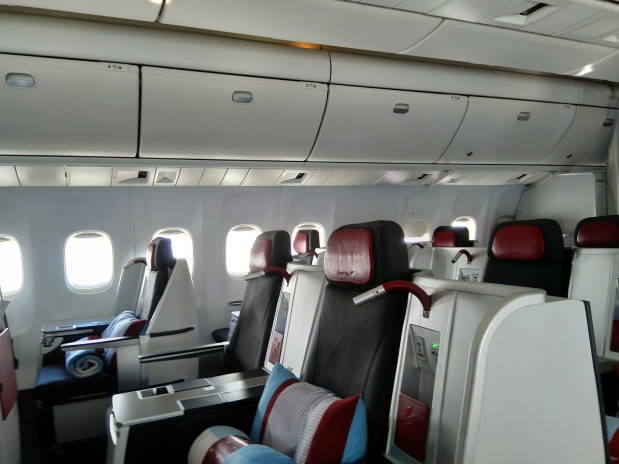
It was not quite this empty (I tried to avoid photographing any passengers, for obvious privacy reasons) as there were a few passengers there, but only a few. Most reservations were canceled.
Is this dramatic response to the coronavirus justified? Parts of China, all of Italy under quarantine? Schools, public gatherings canceled around the world? A cruise ship industry in crisis, a global airline industry poised to lose hundreds of billions of dollars? Planes flying empty just to maintain the respective airlines’ claims on lucrative routes, or planes not flying at all, like the A380 fleet of Lufthansa?
Meanwhile, as Trump himself is fond to point out, the number of conformed coronavirus infections (most of which result in a mild illness, nothing more) worldwide is dwarfed by the number of influenza deaths this flu season.
Of course the flu is (more or less) predictable. The coronavirus is not. And its fatality ratio is much higher.
Even so, I have to admit that I wonder if the cure is causing more harm than the disease.
Then again… if we are just one minor mutation away from a Spanish Flu like pandemic, perhaps the drastic steps are justified. After all, at least some folks are criticizing the WHO for not going far enough, for failing to declare a global pandemic.
No matter what, flying back home in the time of coronavirus was an eerie experience. It was a bit like something straight out of the first episode of a science-fiction television series.
And yes, I was using my limited supply of hand sanitizer quite liberally. After all, you can never be certain…
Today, I answered a question on Quora about the nature of \(c\), the speed of light, as it appears in the one equation everyone knows, \(E=mc^2.\)
I explained that it is best viewed as a conversion factor between our units of length and time. These units are accidents of history. There is nothing fundamental in Nature about one ten millionth the distance from the poles to the equator of the Earth (the original definition of the meter) or about one 86,400th the length of the Earth’s mean solar day. These units are what they are, in part, because we learned to measure length and time long before we learned that they are aspects of the same thing, spacetime.
And nothing stops us from using units such as light-seconds and seconds to measure space and time; in such units, the value of the speed of light would be just 1, and consequently, it could be dropped from equations altogether. This is precisely what theoretical physicists often do.
But then… I commented that something very similar takes place in aviation, where different units are used to measure horizontal distance (nautical miles, nmi) and altitude (feet, ft). So if you were to calculate the kinetic energy of an airplane (measuring its speed in nmi/s) and its potential energy (measuring the altitude, as well as the gravitational acceleration, in ft) you would need the ft/nmi conversion factor of 6076.12, squared, to convert between the two resulting units of energy.
As I was writing this answer, though, I stumbled upon a blog entry that discussed the crazy, mixed up units of measure still in use worldwide in aviation. Furlongs per fortnight may pretty much be the only unit that is not used, as just about every other unit of measure pops up, confusing poor pilots everywhere: Meters, feet, kilometers, nautical miles, statute miles, kilograms, pounds, millibars, hectopascals, inches of mercury… you name it, it’s there.
Part of the reason, of course, is the fact that America, alone among industrialized nations, managed to stick to its archaic system of measurements. Which is another historical accident, really. A lot had to do with the timing: metric transition was supposed to take place in the 1970s, governed by a presidential executive order signed by Gerald Ford. But the American economy was in a downturn, many Americans felt the nation under siege, the customary units worked well, and there was a conservative-populist pushback against the metric system… so by 1982, Ronald Reagan disbanded the Metric Board and the transition to metric was officially over. (Or not. The metric system continues to gain ground, whether it is used to measure bullets or Aspirin, soft drinks or street drugs.)
Yet another example similar to the metric system is the historical accident that created the employer-funded healthcare system in the United States that American continue to cling to, even as most (all?) other advanced industrial nations transitioned to something more modern, some variant of a single-payer universal healthcare system. It happened in the 1920s, when a Texas hospital managed to strike a deal with public school teachers in Dallas: For 50 cents a month, the hospital picked up the tab of their hospital visits. This arrangement became very popular during the Great Depression when hospitals lost patients who could not afford their hospital care anymore. The idea came to be known as Blue Cross. And that’s how the modern American healthcare system was born.
As I was reading this chain of Web articles, taking me on a tour from Einstein’s \(E=mc^2\) to employer-funded healthcare in America, I was reminded of a 40-year old British TV series, Connections, created by science historian James Burke. Burke found similar, often uncanny connections between seemingly unrelated topics in history, particularly the history of science and technology.
I often advise my clients that although automation is great, it must be accompanied by well-tested fallback procedures and training, to ensure that they can continue operations even when systems fail. This is especially important in the case of life-critical applications or, for that matter, in applications related to major centers transportation and infrastructure centers.
Today, there was a perfect example that took place at Gatwick Airport in London. Due to a problem with an underground cable, their flight information system failed. That meant no more functioning displays showing departure times and gate numbers. Yet the airport was able to continue operations with no cancellations or delays, and with very few passengers missing connecting flights.
How? Why, they used whiteboards.
Yes. Whiteboards, maintained by officials carrying walkie-talkies.
Now here is the thing. Although the scenes were described as “chaotic” by some, reality was the exact opposite. To quote a spokesperson: “The airport’s manual contingency plan – which included displaying information manually in the terminals and having extra staff on hand to help direct passengers – worked well and tens of thousands of passengers departed on time and no flights were cancelled.”
This is exactly what “business continuity” means. I hope that the person at Gatwick who insisted that such plans must be in place and ensured that not just whiteboards, walkie-talkies and markers but also adequately trained personnel were available when needed, will get not just a commendation but a nice raise.
It is almost the end of October, and I only added one blog entry so far this month. One reason is that we had a minor health scare: when my wife traveled to Hungary last month, she landed in a hospital on arrival, as she had an unexplained seizure during her flight.
She is doing well, thankfully. She returned home safely, with no lasting effects. There will still be a few more tests to be sure, but the scare is largely over.
This unfortunate incident, however, allowed us to experience first-hand the state of the health care system in Hungary, about which we read so much in recent years. Yes, as it is well known, the system is badly underfunded: salaries are miserably low, and sometimes, even basic supplies are lacking.
But we cannot utter a bad word about the health care professionals that my wife encountered. They were impeccably professional and helpful, going out of their way to assist us, even beyond the call of duty. When my wife’s cell phone was acting up, one nurse volunteered to help fix it with my assistance. When I explained to a doctor that I cannot visit her in person because I happen to be a continent away, he handed the phone to my wife, allowing us to have a conversation (finally!) using a hospital line for a few minutes. They helped with insurance matters, too, and they issued a very thorough discharge report, complete with a CD-ROM containing the results of a CT scan.
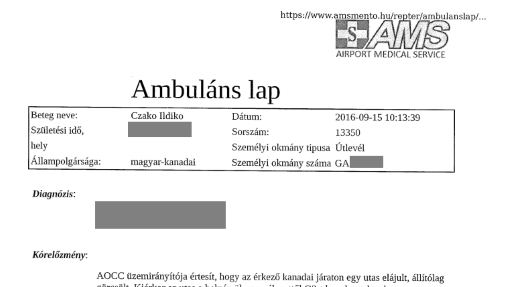
All in all, we have nothing but praise for these overworked and underpaid health care workers, some minor mishaps notwithstanding. They were kind, they were helpful, and every one of them that I spoke with was ready to assist, forthcoming, and flawlessly polite. Thank you for your kind care. Köszönjük szépen.
Tonight, the two most important women in my life are both in the stratosphere.
My wife is en route to Hungary, to visit her Mom. At this moment, she is about halfway across the North Atlantic Ocean.
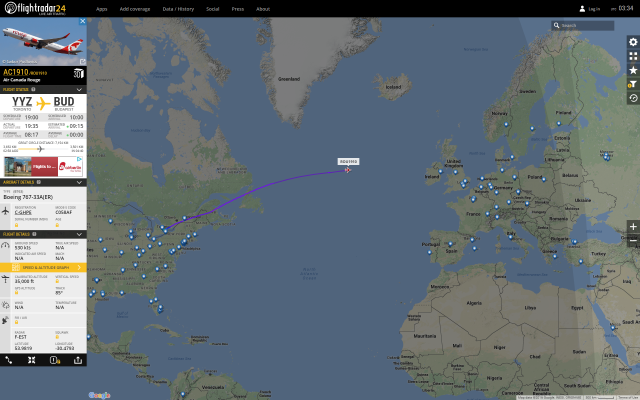
Meanwhile, my Mom is about to land in Beijing, on a memorable adventure I hope: a one-week trip to China with a friend.
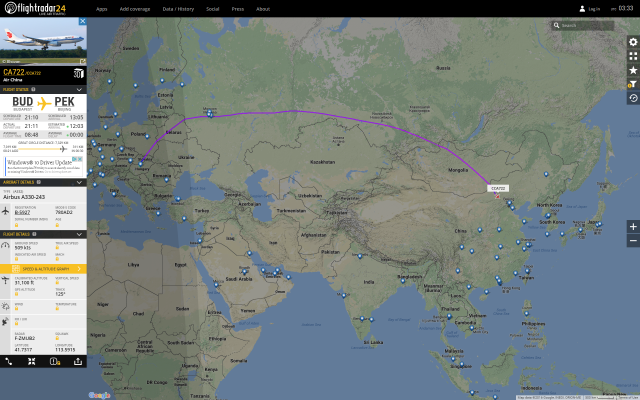
And I am stuck here with three cats, fending for ourselves in the Ottawa wilderness. I would say that life is not fair, but I actually enjoy staying at home for a change. I like my home, and travel is such a chore.
CNN reports that ACARS messages received from MS804 in the minutes before its disappearance indicate a fire on board.
I was able to find online a copy of the screenshot discussed by CNN:
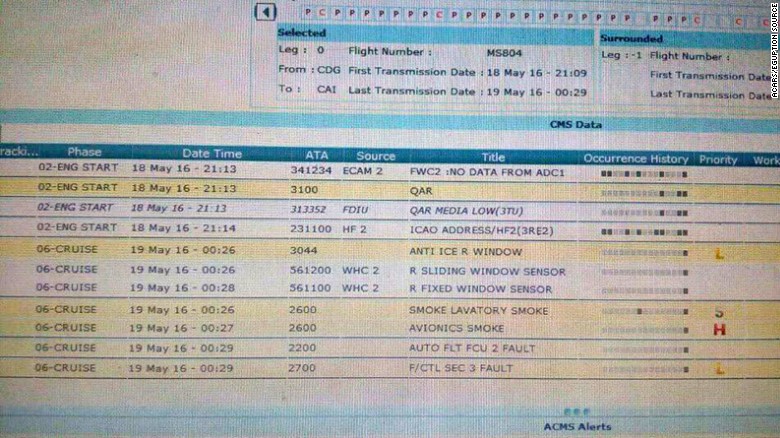
CNN’s talking heads are still discussing the terrorism theory, but in light of these data, it looks increasingly unlikely. It is very difficult to imagine a terrorism scenario that begins with one of the cockpit windows.
This iconic photograph was snapped 60 years ago today from the window of a Boeing 707 prototype.
In case it’s unclear, that airplane is flying upside down. And no, it is not about to crash. It was just in the middle of an aerobatic maneuver called a “barrel roll”.
It was, at least for its test pilot, Alvin “Tex” Johnston, a perfectly normal demonstration of what his new airplane is capable of doing. His company’s CEO, Bill Allen, rather disagreed, but the 707 went on to become a great commercial success and the famous Seattle barrel roll became a matter of legend. I first heard about this barrel roll incident more than 30 years ago from my long gone friend Ferenc Szatmári, physicist, private pilot and storyteller extraordinaire.
Reportedly, Allen never really got over this incident; decades later, when he received a framed copy of the photograph above at his retirement banquet, the memento was accidentally left behind. Then again, if someone gave me a minor heart attack like that (after all, for Allen, the future of his entire company was at stake), I, too, may be inclined to hold a grudge.
I have been neglecting my blog in the past two weeks, but I had a good reason: I was traveling again.
I was once again in Dubai, where I spent some time on the 14th floor of an office building. From that building, I noticed another, very strange edifice with barely a window on its first few floors, and some absolutely giant fans on its roof. I was wondering what it was: a telephone exchange? A data center? No… a central air conditioning plant for a city block. Wow.

Later that evening, we walked to a restaurant in downtown Dubai, and I had a chance to stare at one of the city’s newest attractions (I don’t know how long it has been around, I only just noticed it now), a red streetcar. Lovely.
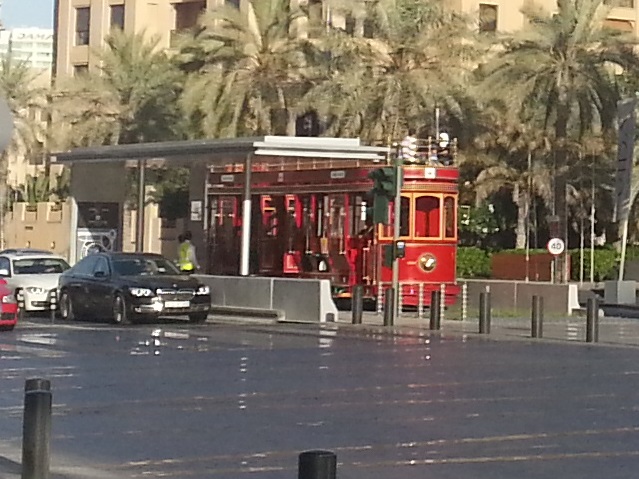
I only spent a day in Dubai before heading off to Abu Dhabi in a rental car. Rather than purchasing a new GPS (or an expensive map for my old Garmin) I decided to rely on Google Maps on my phone. Not that I really needed to; once I found my way out of Dubai, I was quite familiar with the route and the location of my Abu Dhabi hotel. Indeed, I found the hotel without difficulty, and early next morning, I found myself staring at a surprisingly faint desert sunrise, the Sun obscured by sand and fog:
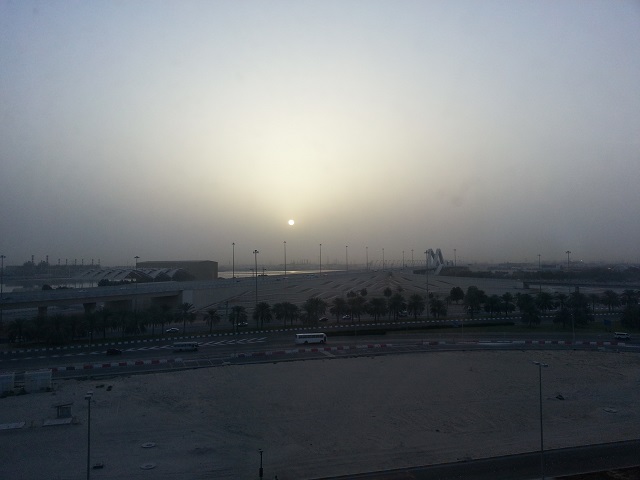
I spent four days in Abu Dhabi, working hard. Having my own transportation really made things easier, not just to commute back and forth between my hotel and my client’s office, but also to do mundane things like going to a supermarket for some fresh fruit or a bottle of Coke purchased at a tiny fraction of the hotel price.
Four days fly by like nothing, and all too soon, I found myself on the highway again, heading back to Dubai. This time around, I used my phone not just for navigation but also as a dash cam:
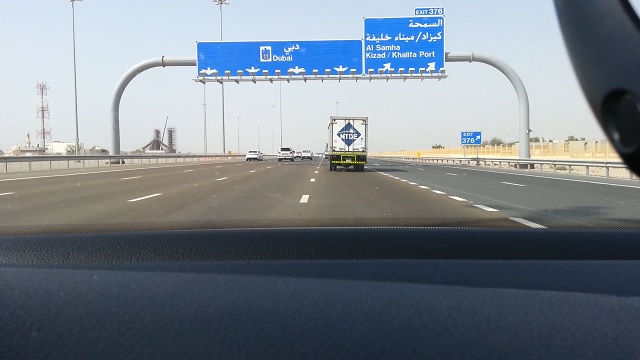
This turned out to be a big mistake. Barely more than ten miles from my hotel, just as I was entering the thickest parts of the freeway spaghetti in Dubai, my phone went dark. I couldn’t for the life of me figure out why a phone’s battery gets depleted when the phone was plugged in just fine. (I solved the mystery today through some experimentation: the use of two applications, but especially the continuous HD video recording overheated the phone, and it stopped charging the battery as a precaution.) Anyhow, I was left to my own devices, so it was with no small amount of pride when, maybe 20 minutes later, I got out of the rental car in front of my hotel, having found the place from memory, driving through downtown Dubai like a native.
The same evening, I took the rental car back to the Dubai Mall, once again navigating flawlessly to the right parking lot, finding the rental agency’s kiosk, and completing the return of the vehicle exactly as planned, nailing the timing spot on for my next meeting.
The next evening, I once again went to the Dubai Mall, but this time on foot. The hotel is about a mile from the Mall. Normally, walking a mile is no big deal, but try doing it in 36°C weather! I felt very brave. Not only did I walk to the Mall, I also walked back from the Mall, after I did some shopping (some gifts and once again, some groceries). On the way back, I paused for a moment, looking at (and listening to) the cacophony of non-stop large scale construction right across the Mall:
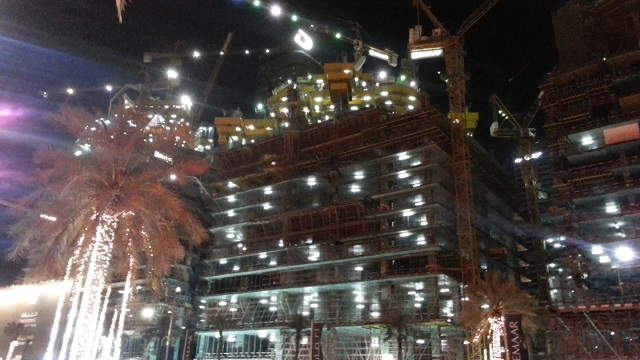
I spent two more days in Dubai, again very busy. On Sunday, I checked out of my hotel, heading to that same 14th floor office again… and en route, I got wet. There was rain! Not a lot of rain to be sure but still, any rain is a delightful experience when you are in one of the driest places of the entire planet.
Finally, Sunday evening arrived and once again I was heading back to Dubai airport. Heading home.
Halfway through the flight, I looked out my window and saw a half moon over a deep blue sky. It was beautiful.

And then, after a grueling 14.5 hour nonstop flight, I was at Washington’s Dulles airport again, going through a surprisingly quick, efficient, and painless border and customs inspection (the concept of international transit does not exist at North American airports.) As I was walking towards my Ottawa departure gate, I encountered a delightful little facility:
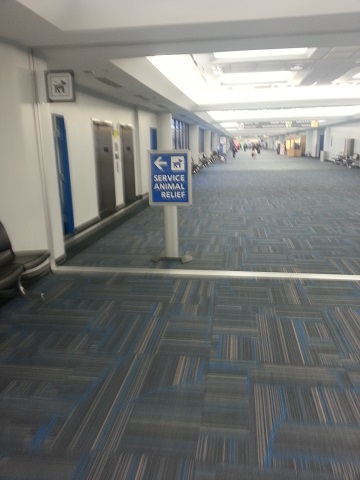
Yes, a rest room for canines! As the door was open, I was even able to take a peek, although for some reason, my phone camera was badly out of focus:

Even in this blurry picture though, perhaps it is clear that the room contains a piece of a fence, some fake grass, and a plastic fire hydrant replica, offering maximum comfort for canine companions. It really gave me a good laugh!
And then, after a brief delay (our aircraft was late inbound), I was flying again. Less than 90 minutes later, I was at Ottawa airport, and soon in a taxi, heading home.
And I am still playing catch-up. So many little things pile up in two weeks!
I was quite doubtful about the theory that Germanwings 9525 was brought down intentionally by its co-pilot. I was more inclined to bet on a health problem. Perhaps I could argue that in a sense, I was right: mental illness can be just as debilitating as any physical condition. And a person suffering from severe mental illness can be quite capable of doing unspeakable, irrational things, whether it is due to “voices”, an exaggerated sense of self, or whatever.
In response, airlines around the world are now instituting the “two person rule”, requiring two members of the crew to be present in the cockpit at all times. Like the reinforced cockpit door, I wonder if this recommendation is based on the best scientific analysis available, or if it is another example of knee-jerk “security theater”.
I am especially concerned because in response to a very low probability event (a pilot going berserk and locking the other pilot out), we introduce another possibility, the probability of which may in fact be higher: that a non-pilot member of the crew gains access to the cockpit with nefarious intent.
Arguably, this is replacing one black swan with another black swan but still… think of the reinforced cockpit door itself. It was supposed to prevent another 9/11-like scenario, however unlikely it is for one to occur again; instead, it introduced its own unique dangers, and now claimed 150 lives. Not only that, but I just found out that the door mechanism itself has been responsible for at least one unscheduled landing, when it began smoldering and the resulting smoke caused pilots to divert.
Wouldn’t it make more sense to listen to the professionals, say, at the American NTSB and ask for their informed analysis and opinion before introducing these regulations?
It’s all over the news this morning: the young, inexperienced copilot (or maybe not that inexperienced: he was recognized by the FAA in September 2013) was in the cockpit, the pilot was locked out, and the copilot deliberately set up the plane for descent with the intent to commit mass murder-suicide.
However, I have lingering doubts. Specifically, I think it’s too early to discard concerns about the copilot’s health.
We learned that in the first 20 minutes, the conversation between the two pilots was cheerful, but during the last 10 minutes, as they reviewed the landing checklist, the copilot’s responses were “laconic”.
Could it not be that the copilot was experiencing a severe health problem, for instance, a stroke?
Nah, how could that be, he was only 28!
Except that I personally knew a 28-year old young man, an engineer in seemingly perfect health, no destructive habits, nice, intelligent, soft spoken, gentle: only to be found dead in his bedroom one day, after he suffered a fatal brain aneurysm.
Confusion caused by the onset of a stroke or aneurysm may also explain why the copilot may have entered incorrect information into the plane’s autopilot. It may also explain why he never said a word.
One thing it does not explain is why the pilot was unable to enter the cockpit using an emergency code. It is not clear to me what procedures were available to the pilot at this point, but if the copilot had to actively prevent the pilot from entering the cockpit, then obviously the suicide theory must prevail.
Regardless of the outcome, I also consider these 150 (or 149) innocent lives victims of post-9/11 hysteria. In our fear over the possibility that hijackers with the ability to pilot a plane might enter the cockpit, we made sure that it is impossible to enter to cockpit in a legitimate emergency… something that is far more likely to happen than another 9/11-style hijacking. Sadly, I fear that this is not the last time that people get killed as a consequence of our thoughtless, knee-jerk response to terrorism that is based on ignorance, not facts and scientific analysis.
Why would a perfectly good airplane, flying along its designated route in broad daylight over Europe, suddenly decide to descend in an orderly fashion until it flew into the French Alps?
Maybe we will find out when the black boxes are analyzed. (One reportedly has been found already.) Given the controlled nature of the descent and the fact that the aircraft never deviated from its planned route, I fear that it will turn out to be something blatantly stupid and trivial, such as the autopilot’s altitude hold being accidentally disengaged, or the wrong value entered.
I am still digesting the news, which I received while in Hungary, that Leonard Nimoy, aka. Mr. Spock, is no longer with us.
And now there is breaking news that Harrison Ford, aka. Han Solo, aka. Indiana Jones, crashed while flying solo in a vintage WW2 aircraft in California. The good news: according to the LA Fire Department, his injuries were moderate and he was alert as he was transported to hospital.
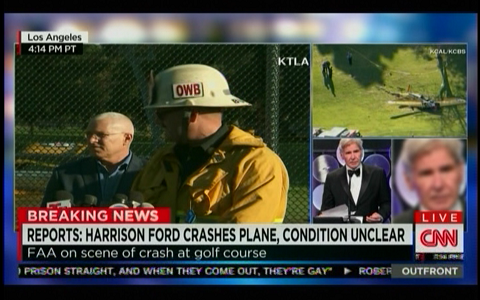
I wish him a speedy recovery.
Five days ago, I was sitting on an Emirates Airlines flight from Dubai to Budapest.
Our flight took an unusual route. Normally (well, at least within my limited experience) such flights take a route north of Iraq, flying over Iranian airspace towards Turkey. Not this time: We flew across the Saudi desert instead, then turned north over the Sinai peninsula before entering Turkish airspace and turning northwest again. I was wondering about that kink in our trajectory: was it weather or perhaps some airspace over the Mediterranean was closed for military reasons?
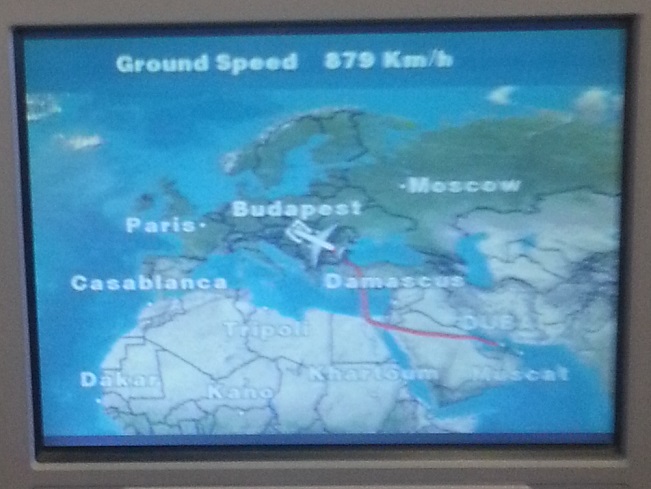
As a service to business class customers, Emirates provides a limo service to the destination of your choice on arrival. I was wondering how I would find the limo pick-up location, but it was easier than I thought: the chauffeur was waiting for me at the customs exit, holding up a sign bearing my name. During the journey to my hotel, he told me about his son who wishes to become a particle physicist at CERN. So for a while, we were discussing the Higgs boson and teraelectronvolts, instead of more customary topics, like Hungarian politics.
I rented a car in Budapest, for my mother and I to take a short trip to southern Hungary, to visit my mother-in-law. As we had the car for a whole weekend, on Sunday we decided to take another small trip, this time to the north of Budapest, the small but historical city of Visegrád.
I used to live in Visegrád, from 1974 to 1977, mostly in this building:
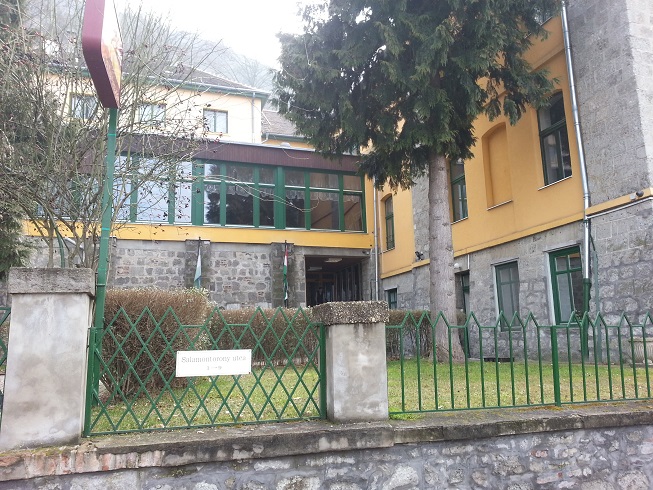
At the time, this building served as a resort owned by the Hungarian Industrial Association. As a member of a crafts artisan cooperative, my mother was entitled to vacation in this place, which we did in the spring of 1974. This is how she came to meet my stepfather who at the time was the manager of this facility. To make a long story short, we lived in the manager’s apartment for several years, while my parents built a new house in the same town. I have fond memories of this place.
Today, it serves as a home for the elderly. It seems to be well taken care of. Much to my surprise, one of its terraces appears to have been converted into a chicken coop, complete with a rather loud rooster:
Other than these two excursions and a brief visit to a 91-year old friend who recently had a serious health crisis, I spent most of my time at my parents’ place, a small apartment on the Buda side, nearly filled by a giant dog and his favorite toy:
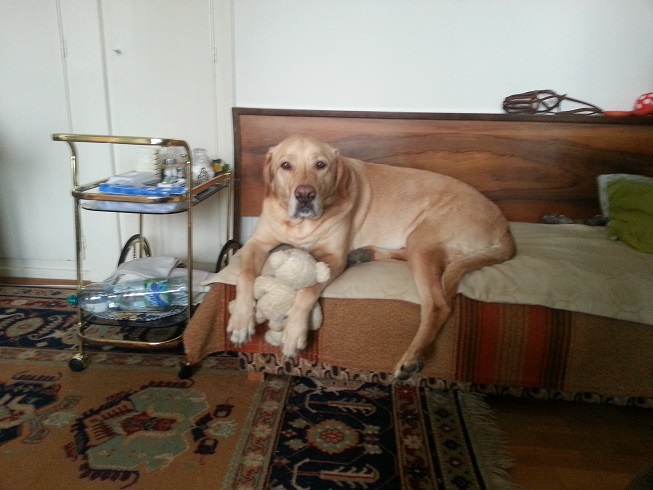
My parents are very fond of this animal. He is nice, but I remain committed to cats. They are quieter, smell nicer, and require a whole lot less maintenance.
And all too soon, I was on another airplane, flying “business class” on British Airways to London. I had to put “business class” in quotation marks, as there was ridiculously little legroom on this middle-aged A320:

At least, the middle seats were converted into an extra tray instead.
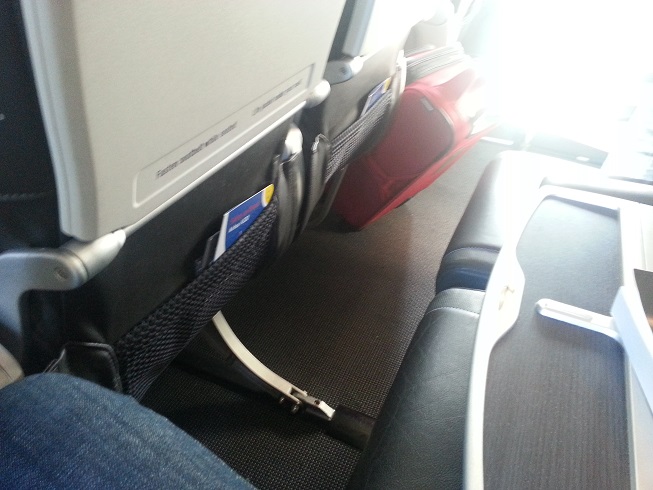
And the flight left Budapest nearly an hour late. The reason? The air crew arrived in Budapest late the previous night, and they had to have their mandatory rest. This presented a potentially serious problem for me: the possibility that I would miss my connecting flight, which, to make things worse, was purchased separately. I probably broke some records at Heathrow Airport as I managed to make it from the arrival gate in Terminal 3 to the Terminal 2 departure gate in only 32 minutes, which included a bus ride between terminals and going through security. I made it with about 10 minutes to spare. I checked and I was told that my suitcase made it, too.
I have to say, while I like both Air Canada and British Airways, their service doesn’t even come close to the quality of service I enjoyed on Emirates or Etihad. And I am not just referring to legroom or the age of the aircraft (the Emirates flight to Budapest was a really aged A330 and the seats, while a great deal more comfortable than these British Airways seats, were nonetheless a little cramped) but also the attentiveness of the staff on board.
Still, the flight was pleasant (except for some rather severe turbulence near the southern trip of Greenland), and some eight hours later, I was back in sunny snowy Ottawa. The land of deep freeze, where the Rideau Canal is breaking all kinds of records, having been open for well over 50 consecutive days already.
I am back from another round of globe-trotting. I spent a week in the UAE, in Dubai and Abu Dhabi, followed by a very brief detour to Budapest to visit my parents.
On arrival to Dubai, we landed nearly an hour late. The reason: a massive sandstorm, which still blanketed the city the next day. Sandstorms can be just as scary and dangerous as snowstorms here in Ottawa: they can reduce visibility to near zero, and the sand can cover roadways in no time. In fact, sand is worse than snow in one respect: it does not melt away.
I was taken to Abu Dhabi by car and during that trip, I saw the rarest of desert wonders: rain.
I was unable to book a room in the hotel of my choice in Abu Dhabi, as most hotels were full due to some defense exhibition. I did, however, find not a room, but a whole apartment at a very modest price in downtown Abu Dhabi, in a brand new apartment hotel called Bin Majid Hotel Apartments (second building from the left):
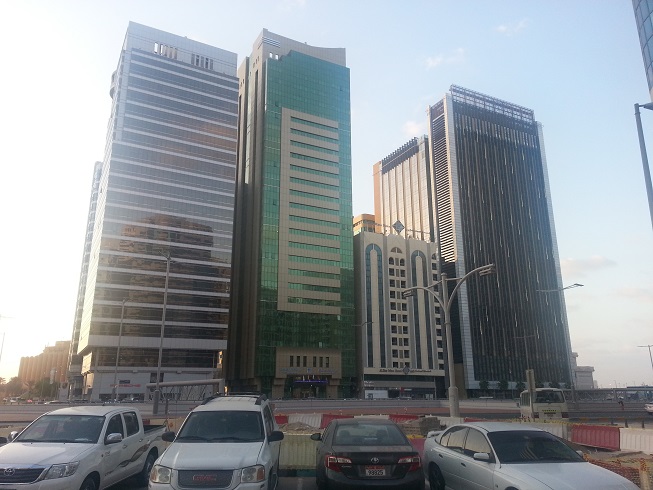
I had a one bedroom apartment, fully equipped, with a beautiful view of the sea:
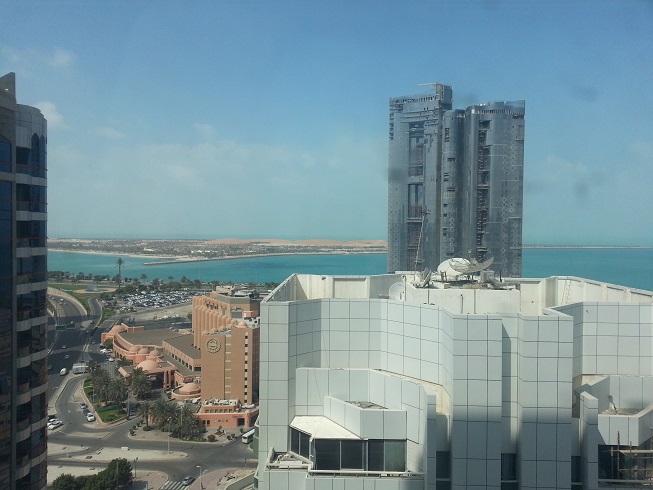
Around the hotel, I befriended several cats. OK, maybe befriended is too strong a term, but one of them was certainly friendly for a while. It was a mostly white cat with a tabby tail; young, probably, but also rather small and skinny. When I saw this cat for the second time and let her (?) sniff my fingers, she would not stop following me. She rubbed against my leg, dropped on her side onto my shoes, and even when I picked her up and placed her back on a safe sidewalk, she continued to come after me. Only after I picked her up and put her onto a stone ledge did she take offense: she jumped off the ledge and disappeared under a parked car. I hope I did not offend her too deeply. I have not seen her afterwards. However, on my last morning in Abu Dhabi, I went looking for her and found instead another, equally tiny and skinny male cat: obviously an adult male, it was a tabby with a heavy limp and only one functioning eye. I felt heartbroken for these cats, although I have been assured that in the UAE, cats are generally not treated badly.
As always, the food in the UAE was both tasty and spectacular. One evening, a colleague took me to a restaurant recently opened by one of his friends. Here, we were treated with a spectacular feast:
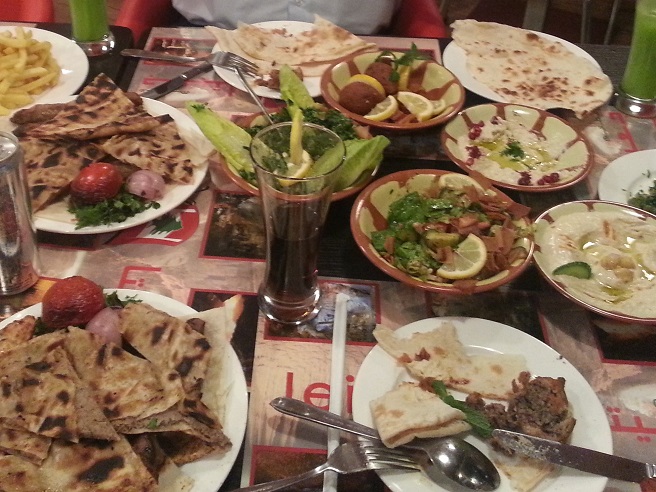
Yum! My only regret is that I couldn’t eat it all. (Actually that’s not true: my other regret is that I came back heavier than I left, which is most unfortunate but not at all unusual when visiting the UAE.)
Then all too soon, it was time to leave. I boarded a direct flight from Dubai to Budapest, a recently introduced route by Emirates Airlines. After take-off, I enjoyed a spectacular view of downtown Dubai, dominated by the world’s tallest skyscraper, the Burj Khalifa, from my airplane window. Sadly, my attempts to take a picture were not very successful.
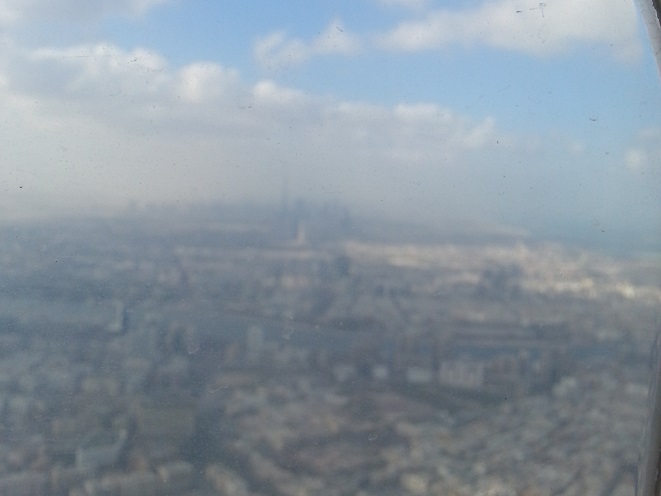
And just like that, this part of my journey under the desert sun, a few very busy workdays in Dubai and Abu Dhabi, was over.
It appears that an Indonesian AirAsia flight with over 160 souls on board vanished a few hours ago.
Here is the last track of the flight from flightradar24.com:
I don’t know if the tracking ended because the flight vanished at that point, or perhaps it just flew out of range of ground-based facilities and had no appropriate satellite service subscription like ADS-B. I guess we shall find out in the coming hours or days.